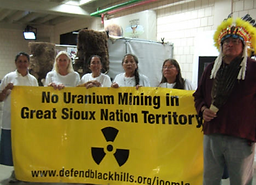
Meta-Autunite: Be Careful What you Dig For
by Elliott McCloskey
When you look at this meta-autunite, you see a catch-22.

This sample of meta-autunite reveals the brilliant green and yellow hues of the mineral in its natural state.
Lavinsky, Rob. “Meta-Autunite.” Photo. geologypage.com. N.p. 2016. Web. 1 Nov. 2018. < http://www.geologypage.com/2014/06/meta-autunite.html>.
Meta-autunite is a uranium-based mineral. Uranium is a catch-22, or a complex paradox that remains unresolved because of co-dependent conditions. In its basic state, lying innocently in Earth's crust, uranium isn't inherently a force of good or evil. Instead, it is the paradox that involves the rock's interaction with humanity that gives the mineral its power to become twisted up in the struggle of vice and virtue, of politics and power. The rock become a vector for the human compulsion to cultivate our survival in the natural world while coming to terms with our exploitation of it. Whether we use the mineral for weapons of mass destruction, for energy plants, or simply leave it sitting pretty in the ground while potentially worse replacements are used, we are losing something extraordinarily valuable, making uranium one of the most prominent catch-22s of our time.

Under natural circumstances, this is a decay chain of uranium. Many of these daughter products and the radiation released in the decay processes are just as nasty and harmful (or more so) than uranium, as shown by the elements radium, radon, polonium, lead, thallium, and mercury, many of which can be radioactive.


Kline, Curtis. “Uranium Mining and Native Resistance.” Photo. interncontinentalcry.org. ICC. N.d. Web. 1 November 2018. <https://intercontinentalcry.org/uranium-mining-and native-resistance-the-uranium-exploration-and-mining-accountability-act/>.
From the onset of World War II until almost 1972, the United States Government was the sole purchaser of US uranium ore. Uranium mining brought many Native Americans and others to work in the mines and mills. Many times, this occurred on Native American reservations.
“Decay Chains.” Digital Image. “Nuclear Forensic Search Project.” Metadata. N.p. N.d. Web. 4 November. 2018 <http://metadata.berkeley.edu/nuclear-forensics/Decay%20Chains.
html>.

The is the meta-autunite specimen on display at the Orma J. Smith Natural History Museum on
The College of Idaho campus.
The Chernobyl accident occurred in 1986
in the Ukraine and was deemed the worst
nuclear accident in history.
In a nuclear reactor, this diagram illustrates the basic process of a nuclear chain reaction
of the fission of uranium by firing a neutron at a certain isotope at it, releasing more
neutrons that will hit more uranium nuclei. In this reaction, just a bit of mass is converted
to massive amounts of energy. Both nuclear bombs and nuclear reactors use this reaction. The only difference is that it is controlled by substances like water and boron in a reactor. This shows that just a bit of negligence or error can turn an energy plant into a weapon of mass destruction.

“Chernobyl Disaster.” Photo. wikipedia.org. WikiMedia Foundation. 2018. Web. 4 November 2018. <https://en.wikipedia.org/wiki/Chernobyl_disaster>.
“Nuclear Fission Chain Reaction.” Digital Image. NuclearPower.Net. NPFE. 2018. Web. 4 November 2018. <https://www.nuclear-power.net/nuclear-power/reactor- physics/nuclear-fission-chainreaction>.
